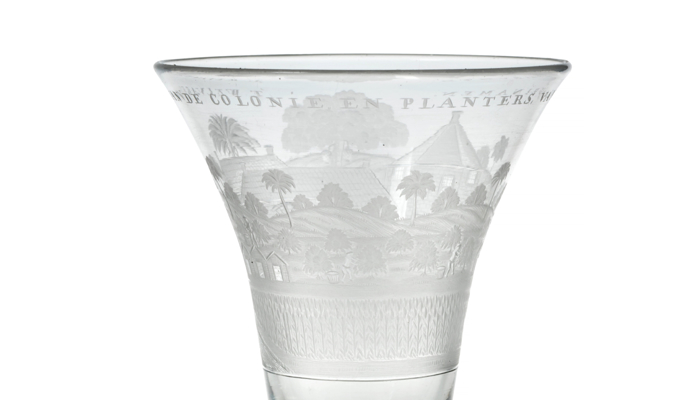
Legacies of the Dutch Slave Trade

Wine glass decorated with engraving of a Dutch plantation at Suriname, engraved by Jacob Sang in Amsterdam, the Netherlands
Glasgow Museums, Burrell Collection, 16.16
Images © CSG CIC Glasgow Museums Collection
9th September 2020
Suriname, on the north coast of South America, became a Dutch colony in 1667, with numerous plantations for the production of commodities such as sugar, cotton, and coffee. Around 300,000 enslaved people from the African continent were bought, sold, and forced to work in inhumane conditions in Suriname by the Dutch.
In the Netherlands, the owners of these plantations often commissioned beautiful wine glasses engraved with scenes of their plantation to celebrate their wealth. This eighteenth-century Dutch drinking glass is engraved with a scene of a tea plantation. The Dutch text around the rim translates as ‘To the Prosperity of the Colony and the Planters of Suriname’. Wheel-engraving on glass – the cutting and grinding of images onto glass using a fast turning metal disc – became a popular technique in the eighteenth century, used commonly by renowned Dutch engravers like Jacob Sang (1720-1786), the engraver of this glass.
Images


The plantation scenes they created on the glass, however, hid the brutal realities for the enslaved people in Suriname. This glass shows an idealised, pastoral scene of a tea plantation; enslaved Africans pick leaves from tea bushes in front of a large warehouse with machinery and a watermill against a background of mountains and palm trees. There is no suggestion in the scene of the dangerous working conditions of the enslaved people; forced to work long hours, in intense heat, and subject to cruel tortures by the white planters.
These engraved scenes were not just for the glorification of the Suriname plantations, but to enforce and emphasise the hierarchies employed there between the planter and the enslaved workers. The engraving depicts a white planter speaking to an enslaved African man. While the face of the white European planter is engraved to remain opaque; the faces of the enslaved Africans has been deliberately cut and polished so that when dark alcoholic liquid was poured into the glass, it would make their faces show up as black.
This glass is one of the 9000 fine and decorative art objects donated to the city of Glasgow in 1944 by shipping magnate, Sir William Burrell, and his wife, Constance, Lady Burrell. The Burrell Collection museum is undergoing a major refurbishment and redisplay. This glass will feature in a new Burrell display about the legacies of the transatlantic slave trade and its impact on the creation of decorative art which marked the wealth and profits of the slave trade for their white European owners. The display has been created in consultation with D/ecology, a group that provide training for the promotion of anti-racist practice in museums. Along with project curators, and editorial teams, they consulted on the research and text interpretation of this display to make sure Glasgow museums continues its commitment to be transparent and representative of the true legacies of the slave trade.
Laura Bauld,
Burrell Project Curator
